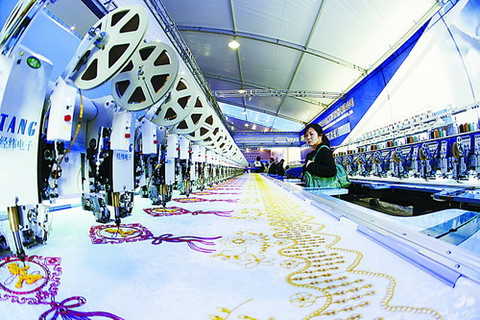Textile industry: "Pollution of large households" transformation of green manufacturing pioneers
Located in Jiayu County, Hubei Province, Hubei Jialinjie Textile Co., Ltd., with a total area of ​​about 200,000 mu, has only two full-time cleaners.
The area is very clean and can be seen to be carefully maintained. Hu Zhen, general manager of the company, said that caring for the environment is a matter of philosophy. Every employee has this string, and there are not many cleaners.

Textile industry
The Jialinjie project has a total investment of 592 million yuan, and has made great efforts in ecology, green and intelligence. It relies on advanced equipment to improve the dyeing and finishing process of high-grade fabrics, and achieves a clean production process in the true sense of dyeing and finishing.
"We have been worried that textile printing and dyeing enterprises will move from the east to the central and western regions, and will also bring pollution to the central and western regions. Hubei Jialinjie has made a good demonstration, and the future transfer enterprises can use this as a model. "On December 12, at the 2016 National Textile Industry Ecological Civilization and Green Development Work Conference, Donghua University professor Yan Danli commented.
Hubei Jialinjie is the fourth stop of China Textile Ecology Miles. At each stop, the textile enterprises inspected by the expert committees are completely different from the “pollution households†in people’s stereotypes.
Sun Huaibin, vice president of the China National Textile and Apparel Council, recalled that the first stop of Wanlixing was Guangdong Mutai. This is a printing and dyeing company, but the plant is full of lush vegetation, even the top floor of the office building is a waterfall, a factory garden. Yin Huilai, Chairman of the Board of Directors of Mutai Company, said that since 2002, there have been dozens of energy conservation and environmental protection projects developed and implemented by them. The investment in environmental protection and energy conservation has exceeded 60 million US dollars.
Sun Huaibin said that the textile industry, as the forerunner of China's green manufacturing development, first proposed the “five principles†for the establishment of green factories in the textile industry: plant intensification, harmless raw materials, clean production, low-carbon energy, and waste recycling. .
Textile has always been regarded as a big polluter, a large waste water, and a hat of “traditional industry†and “outdated production capacityâ€. But in fact, the change has already happened.
"The national laws and regulations on the environment have been formulated more and more rigorously, and the ecological civilization has also been promoted to the height of the national strategy." Gao Yong, secretary of the Party Committee and Secretary General of China Textile Association, told the Science and Technology Daily reporter, "We dare to say that the main textile industry Enterprises are 'achieving the standard' in terms of eco-friendliness."
Lufeng Weaving & Dyeing Co., Ltd. mainly produces high-grade fine cotton garment printing and dyeing fabrics. It is a national high-tech enterprise and national printing and dyeing non-iron fabric product development base. The company's foam finishing technology can reduce the energy consumption of natural gas drying by 40%, reduce water consumption by 50%, and reduce dyeing chemicals and additives by 30%. Jiangsu Flumes Environmental Protection and Energy Saving New Materials Co., Ltd. started from the corner scrap and waste filter bags, forming a circular economy model of “production – use – recycling – recyclingâ€. Each year, the company can recycle more than 8,000 tons of corner scraps, and at the same time recycle nearly 1 million tons of used filter bags in coal-fired power plants, cement plants, steel plants, waste incineration plants and other applications, opening up a new industrial economy.
These textile companies are often located upstream of the industrial chain. Ren Wenwei, director of the WWF Shanghai Center, said that internationally, brands located downstream are concerned about their brand image. They also hope to start from the source and build a green supply chain. When doing the industrial park demonstration point project, Ren Wenwei found that textile enterprises are still considered to be large energy consumers, and they are listed in the blacklist of loans in some financial institutions. Enterprises will face financial obstacles when carrying out energy conservation and emission reduction work. “I hope that the local authorities will change their thinking and turn the extensive control across the board into targeted and refined control.â€
While practicing green manufacturing, there are still many problems to be solved. Gao Yong said that from the perspective of the textile industry, the total amount of water used for water resources is large and the water use efficiency is low. In terms of three wastes, the total amount of wastewater and pollutants are large, ranking third in the national industry. In terms of solid waste, it is mainly sludge and waste textiles. The sludge problem needs to be solved in combination with the water treatment process, and the reuse of used textiles requires extensive participation by the whole society.
Wenzhou’s second batch of listed companies this year, these clothing brands are listed
Cotton futures hit a low rebound and the spot is weak
The green development of the textile industry is in jeopardy

Editor in charge: Liu Xiaomei
What is meltblown nonwoven fabric?
Meltblown Non Woven Fabrics are the core materials of masks and air filter cloths. Meltblown Non Woven Fabrics mainly use polypropylene as the main raw material, and the fiber diameter can reach 1-5 microns. Meltblown Non Woven Fabrics has many voids, fluffy structure and good wrinkle resistance. The ultra - fine fibers with unique capillary structure increase the number and surface area of fibers per unit area, so that the melt-blown non-woven fabric has good filterability, shielding and thermal insulation. properties and oil absorption. Meltblown Non Woven Fabrics can be used in Air Filter Material, liquid filter materials, isolation materials, adsorption materials, mask materials, thermal insulation materials, oil-absorbing materials and wipes.
Meltblown Nonwoven Fabric,Meltblown Nonwoven,Electrostatic Meltblown Nonwoven,Meltblown Nonwoven Polypropylene,Melt Blown Nonwoven
Huamaotek Nonwoven Co., Ltd , https://www.hmnonwoven.com
